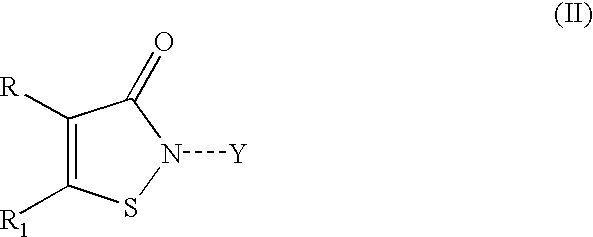Halocyanoacetamide antimicrobial compositions
a technology of halocyanoacetamide and composition, which is applied in the field of stable antimicrobial compositions comprising halocyanoacetamide, can solve problems such as discoloration of solutions
- Summary
- Abstract
- Description
- Claims
- Application Information
AI Technical Summary
Benefits of technology
Problems solved by technology
Method used
Image
Examples
example 1
[0037] To test the stability of DBNPA in various solvents, samples were prepared by combining 2.0 g DBNPA with 8.0 g solvent in 30 ml glass screw cap vials. Samples were capped and shaken until all of the DBNPA was dissolved, then stored at 60.degree. C. and analyzed by high pressure liquid chromatography (HPLC) with UV detection at the indicated time intervals. Results are shown in Table 1.
2 TABLE 1 % DBNPA retained Solvent 1 week 2 weeks 3 weeks 4 weeks 86% dipropylene glycol in water* 49 NA NA NA 75% dipropylene glycol in water* 79 NA NA NA 62% dipropylene glycol in water* 95 NA NA 20 dimethyl formamide* 73 46 NA NA triethylene glycol dimethyl ether* 15 0 NA NA octyl pyrrolidone* 62 50 45 NA methyl amyl ketone* 9 12 0 NA PGMEA* 80 65 61 45 ethyl acetate 100 100 100 100 GTA 92 100 100 100 diethyl phthalate 100 98 98 98 *comparative, not representative of the present invention. NA = not analyzed
[0038] The above results demonstrate that halocyanoacetamides, such as DBNPA, are unstab...
example 2
[0039] Emulsifiable concentrate formulations containing DBNPA were prepared in 30 ml glass screw cap vials according to the amounts shown in Table 2 to test the stability of halocyanoacetamide in the presence of surfactant. Samples were prepared by mixing the ingredients in the vials which were then capped, shaken until the DBNPA dissolved.
[0040] The compositions containing DBNPA, GTA and surfactant (Tween.TM. 20 or Neodol.TM. 91-8 (C.sub.9-C.sub.11 linear primary alcohol ethoxylate)) and a comparative composition using 75% dipropylene glycol in water (with 0.4% butylated hydroxytoluene) as solvent, were stored at 55.degree. C. for 6 weeks and the concentration of active ingredient (DBNPA) in the compositions was determined by HPLC at the indicated time intervals. The results are shown in Table 2.
3 TABLE 2 Composition (grams) Sample DBPNA GTA Surfactant Comparative* 2.00 -- -- 1 2.70 7.30 1.0 (Neodol .TM. 91-8) 2 2.85 6.65 0.5 (Neodol .TM. 91-8) 3 2.70 7.30 1.0 (Tween .TM. 20) 4 2.8...
example 3
[0042] Samples were prepared to test the stability of 5-chloro-2-methyl-3-isothiazolone (CMIT) and DBNPA mixtures. The compositions contained 25% DBNPA, 25% of mixture containing 19.75% CMIT and 6.19% 2-methyl-3-isothiazolone (MIT), zero or 5% surfactant, and 45 or 50% GTA. Surfactants were Tween.TM. 20, Triton.TM. DF-12 or Triton.TM. CF-10. The compositions were stored at 50.degree. C. for 4 weeks and the concentrations of active ingredients (DBNPA and CMIT) in the compositions were determined by HPLC at the indicated time intervals. The results are shown in Table 3.
4TABLE 3 0 1 2 3 4 Surfactant Time Week Weeks Weeks Weeks % DBNPA retained Tween .TM. 20 100 97 71 61 54 Triton .TM. DF-12 100 98 95 73 68 Triton .TM. CF-10 100 97 93 77 69 None 100 98 90 85 78 % CMIT retained Tween .TM. 20 100 100 80 75 74 Triton .TM. DF-12 100 100 99 87 85 Triton .TM. CF-10 100 98 96 86 84 None 100 102 97 90 88
[0043] These data demonstrate satisfactory stability of both CMIT and DBNPA in GTA solutions...
PUM
| Property | Measurement | Unit |
|---|---|---|
| Temperature | aaaaa | aaaaa |
| weight | aaaaa | aaaaa |
| stable | aaaaa | aaaaa |
Abstract
Description
Claims
Application Information
 Login to View More
Login to View More - R&D
- Intellectual Property
- Life Sciences
- Materials
- Tech Scout
- Unparalleled Data Quality
- Higher Quality Content
- 60% Fewer Hallucinations
Browse by: Latest US Patents, China's latest patents, Technical Efficacy Thesaurus, Application Domain, Technology Topic, Popular Technical Reports.
© 2025 PatSnap. All rights reserved.Legal|Privacy policy|Modern Slavery Act Transparency Statement|Sitemap|About US| Contact US: help@patsnap.com



